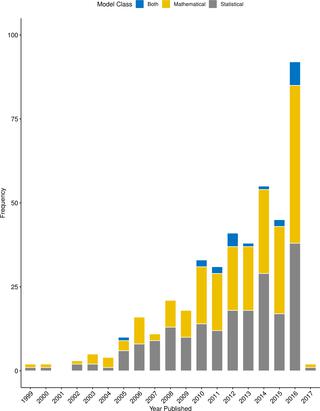Our official English website, www.x-mol.net, welcomes your
feedback! (Note: you will need to create a separate account there.)
A scoping review of importation and predictive models related to vector-borne diseases, pathogens, reservoirs, or vectors (1999-2016).
PLOS ONE ( IF 2.9 ) Pub Date : 2020-01-15 , DOI: 10.1371/journal.pone.0227678 Tara Sadeghieh 1, 2 , Lisa A Waddell 1 , Victoria Ng 1 , Alexandra Hall 1, 2 , Jan Sargeant 2, 3
PLOS ONE ( IF 2.9 ) Pub Date : 2020-01-15 , DOI: 10.1371/journal.pone.0227678 Tara Sadeghieh 1, 2 , Lisa A Waddell 1 , Victoria Ng 1 , Alexandra Hall 1, 2 , Jan Sargeant 2, 3
Affiliation

|
BACKGROUND
As globalization and climate change progress, the expansion and introduction of vector-borne diseases (VBD) from endemic regions to non-endemic regions is expected to occur. Mathematical and statistical models can be useful in predicting when and where these changes in distribution may happen. Our objective was to conduct a scoping review to identify and characterize predictive and importation models related to vector-borne diseases that exist in the global literature.
METHODS
A literature search was conducted to identify publications published between 1999 and 2016 from five scientific databases using relevant keywords. All publications had to be in English or French, and include a predictive or importation model on VBDs, pathogens, reservoirs and/or vectors. Relevance screening and data characterization were performed by two reviewers using pretested forms. The data were analyzed using descriptive statistics.
RESULTS
The search initially identified 19 710 unique articles, reports, and conference abstracts. This was reduced to 428 relevant documents after relevance screening and data charting. About half of the models used mathematical techniques, and the remainder were statistical. Most of the models were predictive (87%), rather than importation (5%). The most commonly investigated diseases were malaria and dengue fever. Around 12% of the publications did not report all the parameters used in their model. Only 29% of the models incorporated the impacts of climate change.
CONCLUSIONS
A wide variety of mathematical and statistical models on vector-borne diseases exist. Researchers creating their own mathematical and/or statistical models may be able to use this scoping review to be informed about the diseases and/or regions, parameters, model types, and methodologies used in published models.
中文翻译:

对与媒介传播疾病、病原体、宿主或媒介相关的输入和预测模型的范围审查(1999-2016)。
背景技术随着全球化和气候变化的进展,预计媒介传播疾病(VBD)会从流行地区向非流行地区扩展和引入。数学和统计模型可用于预测这些分布变化可能发生的时间和地点。我们的目标是进行范围审查,以确定和描述全球文献中存在的与媒介传播疾病相关的预测和输入模型。方法 使用相关关键词从五个科学数据库中检索 1999 年至 2016 年间发表的出版物。所有出版物都必须是英语或法语,并包括 VBD、病原体、储存库和/或载体的预测或输入模型。相关性筛选和数据表征由两名评审员使用预先测试的表格进行。使用描述性统计分析数据。结果 检索初步确定了 19 710 篇独特的文章、报告和会议摘要。经过相关性筛选和数据图表后,相关文件减少到 428 份。大约一半的模型使用数学技术,其余的则采用统计技术。大多数模型都是预测性的(87%),而不是导入性的(5%)。最常调查的疾病是疟疾和登革热。大约 12% 的出版物没有报告其模型中使用的所有参数。只有 29% 的模型考虑了气候变化的影响。结论 存在多种关于媒介传播疾病的数学和统计模型。创建自己的数学和/或统计模型的研究人员也许能够使用此范围界定审查来了解已发布模型中使用的疾病和/或区域、参数、模型类型和方法。
更新日期:2020-01-16
中文翻译:

对与媒介传播疾病、病原体、宿主或媒介相关的输入和预测模型的范围审查(1999-2016)。
背景技术随着全球化和气候变化的进展,预计媒介传播疾病(VBD)会从流行地区向非流行地区扩展和引入。数学和统计模型可用于预测这些分布变化可能发生的时间和地点。我们的目标是进行范围审查,以确定和描述全球文献中存在的与媒介传播疾病相关的预测和输入模型。方法 使用相关关键词从五个科学数据库中检索 1999 年至 2016 年间发表的出版物。所有出版物都必须是英语或法语,并包括 VBD、病原体、储存库和/或载体的预测或输入模型。相关性筛选和数据表征由两名评审员使用预先测试的表格进行。使用描述性统计分析数据。结果 检索初步确定了 19 710 篇独特的文章、报告和会议摘要。经过相关性筛选和数据图表后,相关文件减少到 428 份。大约一半的模型使用数学技术,其余的则采用统计技术。大多数模型都是预测性的(87%),而不是导入性的(5%)。最常调查的疾病是疟疾和登革热。大约 12% 的出版物没有报告其模型中使用的所有参数。只有 29% 的模型考虑了气候变化的影响。结论 存在多种关于媒介传播疾病的数学和统计模型。创建自己的数学和/或统计模型的研究人员也许能够使用此范围界定审查来了解已发布模型中使用的疾病和/或区域、参数、模型类型和方法。











































 京公网安备 11010802027423号
京公网安备 11010802027423号